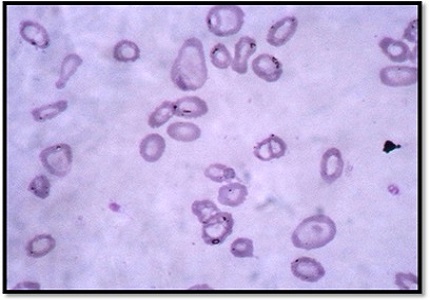Pancytopenia- A clinicopathological analysis of 132 cases
Abstract
Introduction: Pancytopenia is a challenging clinical entity for both clinicians and hematologists. The severity of pancytopenia and the underlying pathology determine the management and prognosis of these patients. Laboratory plays central role in determining the etiology of pancytopenia and thereby guiding the clinician in proper management of patient. The objective of the present study was to study the etiological factor, clinical features, peripheral blood picture, hematological parameters and bone marrow findings in different causes of pancytopenia in this region.
Materials and Methods: In the prospective study carried out, a total of 132 patients of pancytopenia were evaluated for clinical features, hematological parameters, peripheral smear and bone marrow findings in Department of Pathology, Jawaharlal Nehru Hospital and Research Center, Bhilai, C .G. during a two years study period from March 2009 to April 2011.
Results: Among the 132 cases studied, the age of patients studied ranged from 2.5 to 76 years with a mean age of 38.10 years. The maximum number of patients (53.7%) were noted in 2nd to 4th decade of age. Slight male preponderance was observed with male: female ratio 1.5:1. On analyzing for the specific causes of pancytopenia, majority of cases were found to be due to megaloblastic anemia (50 .7%), followed by hypersplenism (10.6.%), malaria (9.8%), leukemia (9.0%) and aplastic anemia (7.5%) cases. Other rare causes includes Wilson disease, Kala azar, HIV, alcoholism etc. Clinical presentation of the patients with pancytopenia varied but pallor was the most common clinical finding (96.9%) followed by fever (59.8%). Dimorphic with macrocytic anemia was the predominant peripheral blood picture. Bone marrow aspiration was done in 101 cases and biopsy in 10 cases. The commonest finding was hypercellularity in marrow with megaloblastic erythropoiesis.
Conclusion: The present study concludes that detailed clinical examination along with readily available diagnostic tools like hematological parameters, peripheral smear and bone marrow aspiration can help in prompt diagnosis and treatment in patients with pancytopenia.
Downloads
References
2. Adamson JW, Erslev AJ. Aplasticanemia. In: Hematology, 7th edition. William WJ, Beutler E, Lichtman HA, eds. New York: McGraw Hill.419-436.
3. Kar M, Ghosh A. Pancytopenia. Journal of Indian Academy of Clinical Medicine 2001; 3(1): 29-34.
4. Tilak V, Jain R. Pancytopenia--a clinico-hematologic analysis of 77 cases. Indian J Pathol Microbiol. 1999 Oct;42(4):399-404. [PubMed]
5. Bello-González SA, Bergés-García A. [Peripheral pancytopenia]. Bol Med Hosp Infant Mex. 1990 Nov;47(11):737-45. [PubMed]
6. Khodke K, Marwah S, Buxi G, Yadav RB, Chaturvedi NK. Bone marrow examination in cases of pancytopenia. Journal Indian Academy of clinical Medicine 2001; 2:55-59.
7. Kumar R, Kalra SP, Kumar H, Anand AC, Madan H. Pancytopenia--a six year study. J Assoc Physicians India. 2001 Nov;49:1078-81. [PubMed]
8. Varma N, Dash S. A reappraisal of underlying pathology in adult patients presenting with pancytopenia. Trop Geogr Med. 1992 Oct;44(4):322-7. [PubMed]
9. Incidence of aplastic anemia: the relevance of diagnostic criteria. By the International Agranulocytosis and Aplastic Anemia Study. Blood. 1987 Dec;70(6):1718-21.
10. Imbert M, Scoazec JY, Mary Jy, Jeuzult H, Rochant H, Sultan C. Adult patients presenting with pancytopenia : A reappraisal of underlying pathology and diagnostic procedures in 213 cases. Haemotol Pathol 1989; 3(4): 159-167.
11. Hossain HA, Akond AK, Chowdhury MK. Pancytopenia-a study of 50 cases. Bangladesh journal of pathology 1992; 7(1):9-12.
12. Keisu M, Ost A. Diagnoses in patients with severe pancytopenia suspected of having aplastic anemia. Eur J Haematol. 1990 Jul;45(1):11-4.
13. Khunger JM, Arunselvi S, Sharma U, Ranga S, Talib VH: Pancytopenia – a clinicohematological study of 200 cases. Lin CK, Hsu HC,Chau WK, Jiang ML, Chiu CE. Reticulocyte count with maturation fraction in pancytopenic evaluation by a fully automated counter. Clin Lab Anal 1993; 7(6):371-375.
14. Lin CK, Hsu HC, Chau WK, Jiang ML, Chiu CF. Reticulocyte count with maturation fractions in pancytopenic evaluation by a fully automated counter. J Clin Lab Anal. 1993;7(6):371-5. [PubMed]
15. Savage DG, Allen RH, Gangaidzo IT, Levy LM, Gwanzura C, Moyo A, Mudenge B, Kiire C, Mukiibi J, Stabler SP, Lindenbaum J. Pancytopenia in Zimbabwe. Am J Med Sci. 1999 Jan;317(1):22-32.



 OAI - Open Archives Initiative
OAI - Open Archives Initiative


